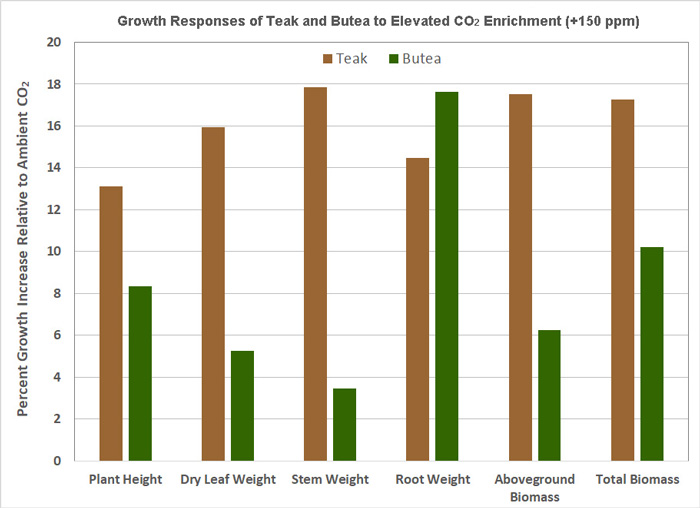| Tweet | Follow @co2science |
Paper Reviewed
Singh, A.K., Rai, A., Kushwaha, M., Chauhan, P.S., Pandey, V. and Singh, N. 2019. Tree growth rate regulate the influence of elevated CO2 on soil biochemical responses under tropical condition. Journal of Environmental Management 231: 1211-1221.
In a typical CO2-enrichment study of trees, Singh et al. (2019) evaluated the growth responses of two tropical species, Teak (Tectona grandis) and Butea (Butea monosperma), over a period of almost four years. The study was conducted at the National Botanical Research Institute in Lucknow, India. Beginning in 2012, Teak and Butea saplings were subjected to either ambient (~395 ppm) or elevated (~550 ppm) atmospheric CO2 concentrations in a free-air CO2 enrichment (FACE) environment. After 46 months the authors harvested the trees to determine their growth responses to CO2. Additionally, they collected and analyzed soil samples to test for soil ecosystem responses under the two different CO2 concentrations.
The above- and below-ground growth responses to atmospheric CO2 enrichment for each tree are presented in Figure 1 below. As indicated there, the approximate 150 ppm elevation in CO2 increased the height, leaf weight, stem weight, root weight, aboveground biomass and total biomass of the faster-growing Teak trees by 13.1%, 15.9%, 17.9%, 14.5%, 17.5% and 17.3%, respectively, and by 8.3%, 5.3%, 3.4%, 17.6%, 6.2% and 10.2%, respectively, for the slower-growing Butea species. Elevated CO2 also impacted rhizospheric soil properties, increasing soil organic carbon, glomalin-related soil protein, microbial biomass carbon and microbial extracellular enzyme activities, which increases were once again greater in the faster-growing Teak (versus the slower-growing Butea) species.
In the future, therefore, both Teak and Butea trees should benefit from the ongoing rise in atmospheric CO2, sequestering more carbon both above ground in their leaves and stems, and below ground in their roots and surrounding soil.

Figure 1. Percent increase in various growth-related parameters of Teak and Butea in response to a 150 ppm rise in atmospheric CO2, as derived from data presented in the authors' Table 1.




